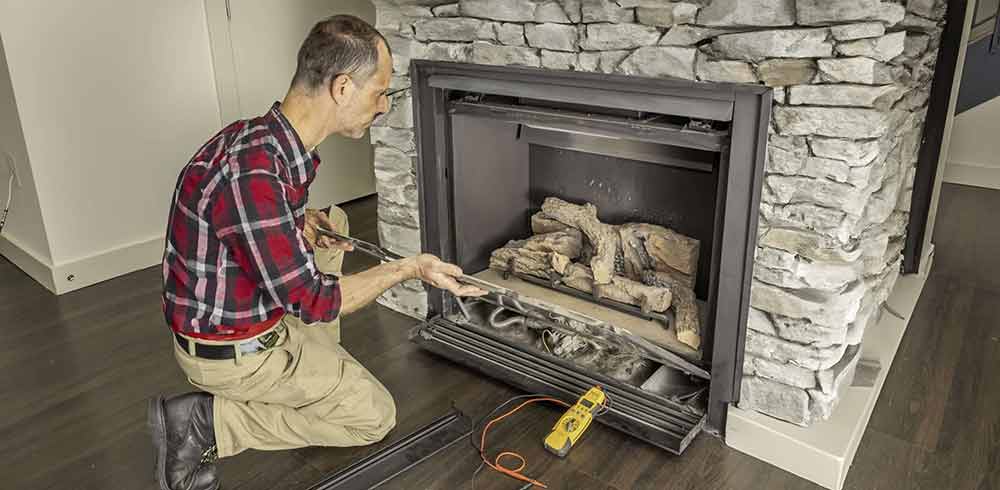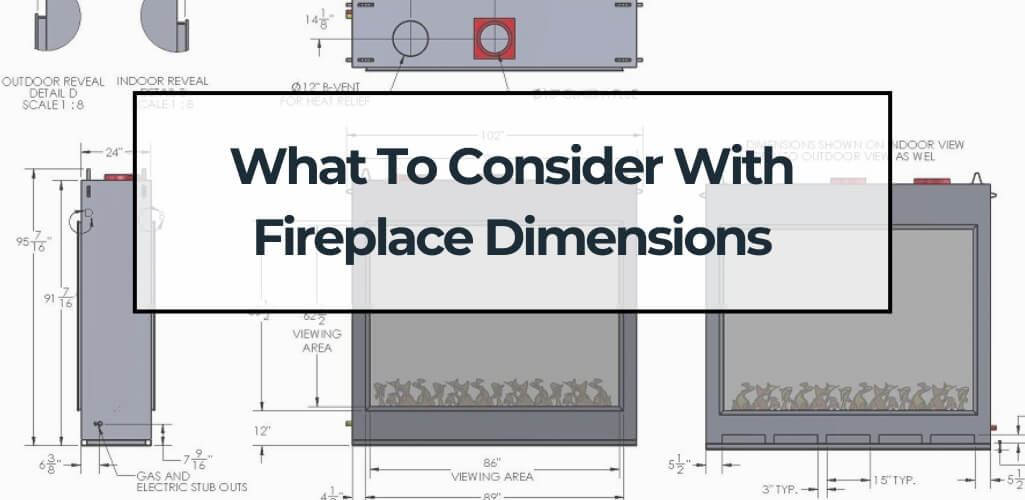For a gas fireplace, the hearth should be at least 16 inches deep and extend 8 inches outward from each side of the fireplace opening. The size of the hearth is crucial for safety and compliance with building codes, as it provides protection from heat and embers.
A properly sized hearth not only enhances the aesthetic appeal of the fireplace but also serves as a protective barrier. When installing a gas fireplace, it is essential to consider the dimensions of the hearth to ensure proper clearances and safety standards are met.
Additionally, selecting the right materials for the hearth, such as granite, slate, or limestone, can add durability and visual appeal to your fireplace setup. Understanding the requirements and dimensions for a gas fireplace hearth is essential for a safe and aesthetically pleasing installation.

Credit: www.fireplacesdirect.com
Importance Of Hearth Size
When it comes to a gas fireplace, the size of the hearth plays a crucial role in both aesthetics and safety.
Regulation Compliance
The hearth size for a gas fireplace must adhere to building codes to ensure compliance.
Safety Measures
Choosing the right hearth size is vital to maintain safety distances and prevent hazards.
Factors To Consider
Gas Fireplace Type
Choose the appropriate gas fireplace type that fits your space and heating needs.
Overall Room Size
Consider the overall room size when determining the size of the hearth for proper scale.
Aesthetic Considerations
Factor in aesthetic considerations to ensure the hearth complements your decor style.
Determining The Right Size
When it comes to determining the right size of a hearth for a gas fireplace, several factors need to be taken into consideration. From gas fireplace requirements to clearance regulations, finding the ideal size of the hearth is crucial for both safety and aesthetic appeal.
Gas Fireplace Requirements
Gas fireplace installations have specific requirements, including the size of the hearth. According to building codes, the hearth must provide adequate protection for the floor and surrounding areas. The dimensions of the hearth are influenced by the type of gas fireplace and the fuel it uses. Ensuring compliance with these regulations is essential for a safe and efficient gas fireplace installation.
Clearance Regulations
Clearance regulations dictate the minimum distance required between the fireplace and combustible materials. This affects the size of the hearth, as it needs to extend a certain distance beyond the fireplace for added protection. Adhering to these regulations is essential for the proper functioning of the gas fireplace and preventing potential hazards.

Credit: www.acucraft.com
Materials For Hearth
When installing a gas fireplace, the size of the hearth is crucial. Gas fireplaces require a non-combustible material hearth to protect the flooring from heat and embers. Consider the building code’s minimum clearance of six inches between the fireplace and any combustible material.
Non-combustible Options
A non-combustible material is essential for constructing the hearth of a gas fireplace. This material is necessary to protect the interior flooring from the heat and embers produced by the fireplace. Most building codes require the use of non-combustible materials for both wood and gas fireplaces. While electric fireplaces do not require a hearth since they don’t have real flames, gas fireplaces do. Here are some popular non-combustible options commonly used for gas fireplace hearths:- Granite: Known for its durability and elegance, granite is a popular choice for a gas fireplace hearth. It comes in various colors and patterns, allowing you to choose the one that complements your interior design.
- Slate: With its natural beauty and textured surface, slate provides a unique and rustic appeal to your fireplace hearth. It is a strong and heat-resistant material that can withstand the high temperatures produced by the gas fireplace.
- Limestone: Limestone is a versatile material that can be easily shaped and carved to create intricate designs for your fireplace hearth. It offers a classic and timeless look that adds sophistication to any room.
- Sandstone: Sandstone is another non-combustible material that is widely used for hearth construction. It is known for its warm and earthy tones, making it a great choice for a cozy and inviting ambiance around your gas fireplace.
- Bluestone: Bluestone is a durable and low-maintenance material that is often used for outdoor fireplaces. However, it can also be a suitable option for indoor gas fireplaces due to its heat resistance and natural beauty.
- Soapstone: Soapstone is a heat-retaining material that provides excellent insulation and distributes the warmth evenly throughout the room. It has a smooth and velvety texture that adds a touch of luxury to your fireplace hearth.
Aesthetically Pleasing Materials
Aside from being non-combustible, the hearth material should also be aesthetically pleasing to enhance the overall look of your gas fireplace. While the non-combustible options mentioned above can also be visually appealing, there are additional materials that you can consider:- Marble: Known for its luxurious appearance, marble can elevate the elegance of your gas fireplace hearth. It comes in various colors and veining patterns, allowing you to create a unique focal point in your living space.
- Travertine: Travertine is a natural stone that offers a timeless and sophisticated look. Its subtle color variations and unique texture can add depth and character to your fireplace hearth.
- Porcelain: Porcelain tiles provide a wide range of design options, including various colors, patterns, and textures. They are highly durable and easy to clean, making them a practical choice for a stylish gas fireplace hearth.
- Quartz: Quartz is a man-made material that offers excellent heat resistance and durability. It is available in a wide array of colors and finishes, allowing you to customize your fireplace hearth to match your desired aesthetic.
- Concrete: Concrete is a versatile material that can be molded into different shapes and sizes. It can be finished with various techniques, such as polishing or staining, to create a modern and industrial look for your gas fireplace hearth.
Installation And Maintenance
Proper installation and regular maintenance are crucial for ensuring the optimal performance and safety of your gas fireplace. From professional installation to cleaning and upkeep, every aspect plays a significant role in maximizing your fireplace’s efficiency and longevity.
Professional Installation
When it comes to installing a gas fireplace, it is highly recommended to seek professional help. With their expertise, they can ensure that the hearth is properly designed and sized for your specific gas fireplace model. Professional installers adhere to local building codes and regulations, guaranteeing a safe and efficient installation.
Cleaning And Upkeep
Maintaining a clean hearth is vital to ensure the overall performance and appearance of your gas fireplace. Regular cleaning helps remove soot, debris, and any potential blockages that may hinder the proper functioning of the fireplace. Here are some important cleaning and upkeep tips:
- Use a soft-bristle brush or a vacuum with a brush attachment to gently clean the hearth, ensuring all the nooks and crannies are thoroughly cleaned.
- For stubborn stains or buildup, a mild soap and water solution can be used. Avoid abrasive cleaners or harsh chemicals that may damage the hearth’s material.
- Inspect the fireplace’s components, such as burners and logs, regularly to ensure they are in good condition and functioning properly. Replace any worn-out or damaged parts promptly.
- Clean and check the venting system to ensure proper airflow and ventilation. A clogged or blocked vent can impair the fireplace’s performance and pose safety hazards.
- Consider scheduling an annual professional inspection and servicing to address any potential issues and to maintain the optimal performance of your gas fireplace.
By following these cleaning and upkeep practices, you can prolong the lifespan of your gas fireplace and enjoy its warmth and beauty for years to come.

Credit: www.efireplacestore.com
Frequently Asked Questions Of How Big Should A Hearth Be For A Gas Fireplace
What Size Hearth Do I Need For A Gas Fire?
For a gas fire, a hearth should be sized according to local building codes. Non-combustible material is necessary to protect flooring from heat and embers.
Do I Need A Hearth With A Gas Fireplace?
A hearth is needed for a gas fireplace to protect flooring from heat and embers.
What Is The Code For The Size Of A Fireplace Hearth?
The code for the size of a fireplace hearth is determined by building regulations, usually requiring a minimum clearance of six inches around a gas fireplace. The hearth must be made from non-combustible materials to protect flooring from heat and embers.
How Much Space Is Needed Around A Gas Fireplace?
A gas fireplace requires a minimum clearance of six inches from any combustible material. It must also be surrounded by a non-combustible material.
What Are The Regulations For A Hearth With A Gas Fireplace?
Most building codes require a non-combustible hearth to protect the flooring from heat and embers.
Conclusion
The size of the hearth for a gas fireplace is crucial for safety and aesthetics. Following the guidelines from building codes and ensuring proper clearance around the fireplace is essential. Consider the material, design, and dimensions to create a functional and visually appealing hearth for your gas fireplace.
Research and plan wisely to create the perfect hearth for your gas fireplace setup.
